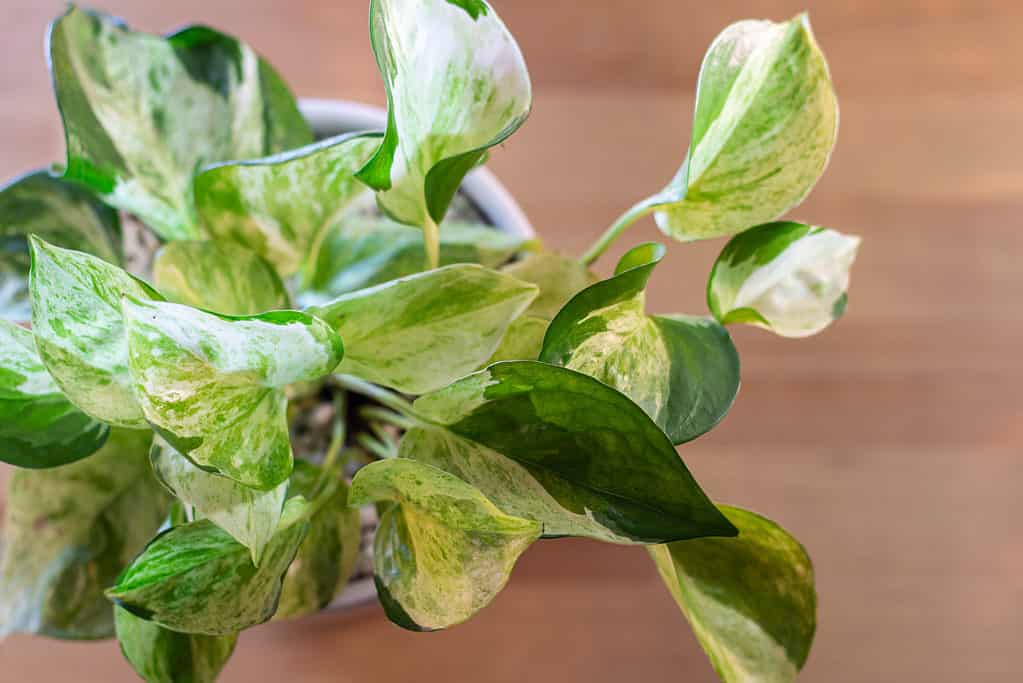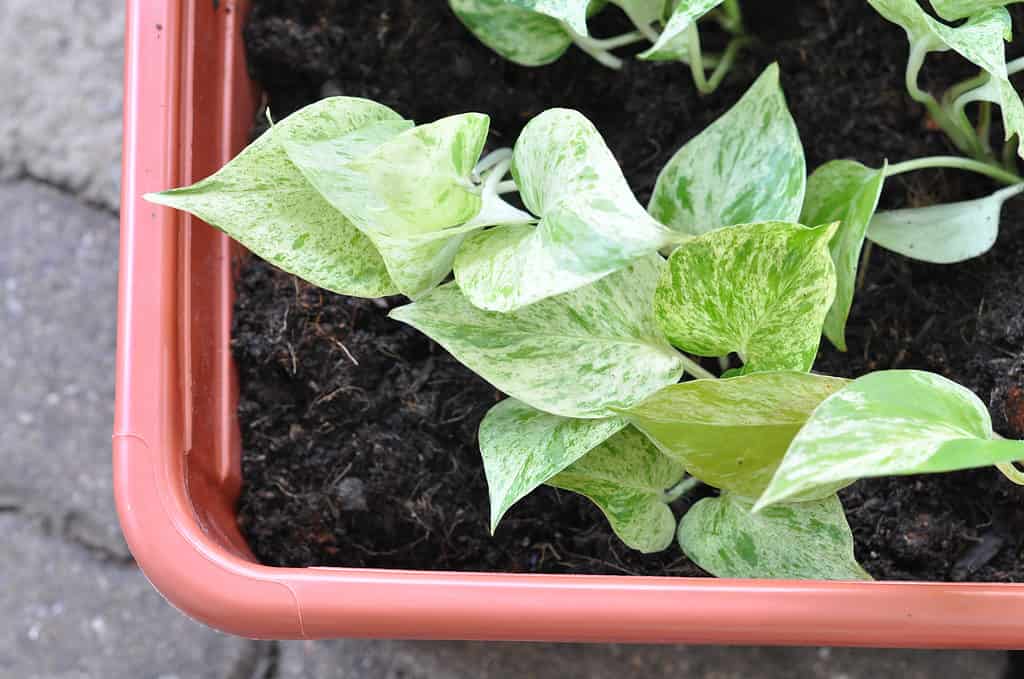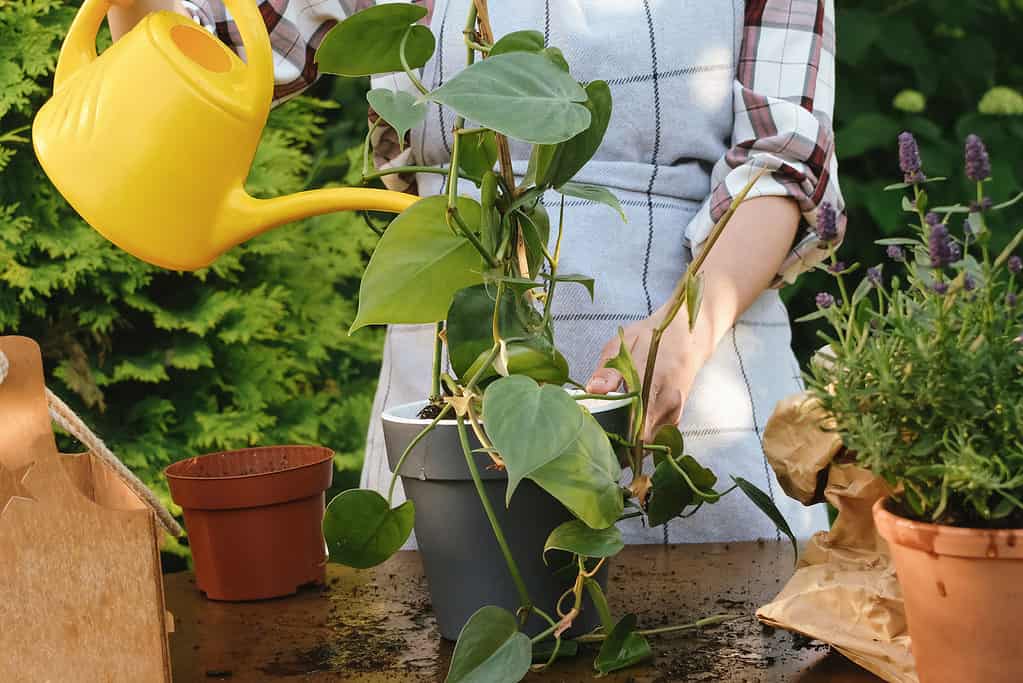If you’re growing the widely popular houseplant pothos, you may be wondering if you’re correctly watering it. After all, under or overwatering your plants can lead to a number of issues and even the death of your plant. Thankfully, caring for pothos is easy and requires quite a low-maintenance watering schedule.
In this guide, we’ll explain how pothos grows in its native habitat, how often to water it, the signs that your plant is not being correctly watered, and how to fix it.
Alright, let’s jump in!
Pothos: Botanical Classification and Natural Growing Habits
Belonging to the arums, or Araceae family of flowering plants, pothos is a tropical plant native to the Solomon Islands of the South Pacific. This plant, like many arums such as the peace lily, produces a spathe and spadix as its flowering structure. A spadix is an upright fleshy stem covered in tiny flowers and is halfway enclosed by a petal-like structure, called the spathe.
However, because pothos is a shy-flowering plant due to a deficiency in the hormone gibberellin, this plant rarely flowers even in ideal natural conditions. Instead, it typically reproduces vegetatively. Through this asexual form of reproduction, a part of the parent plant breaks off and develops its own roots, forming an entirely new plant.
In its natural habitat, this heat and humidity-loving plant grows in the understory of dense tropical trees where it receives indirect sunlight through the tree leaves. You might think this plant thrives with saturated soil but it actually does not do well with soggy roots. While its roots do like moisture, this plant needs to grow in well-draining soil that allows plenty of oxygen to the roots.
So, what does this mean for watering your houseplant pothos? We’ll discuss below.

Pothos is a tropical plant that belongs to the Araceae family of flowering plants.
©Catherine Tribone/Shutterstock.com
Watering Pothos: Soil Considerations
Essentially, to be happy, your pothos plant needs moist soil that drains and is well-aerated. This means that your watering consideration isn’t just about how often or how much you water your plant, because it’s also about what growing medium you’re watering your plant in. As such, it’s important to grow your plant in a well-draining potting mix that retains moisture, but ultimately allows the top couple inches of the soil to thoroughly dry out between weekly watering.
To achieve this, look for a houseplant potting mix, and if the mix doesn’t already contain it, you can add in perlite or coconut coir to improve drainage. If you’re using soil from outside, make sure it’s sandy or loamy soil, rather than compacted soil like clay.

Grow pothos in a well-draining potting mix that retains moisture, but allows the top of the soil to dry out between weekly watering.
©C_banglieng/Shutterstock.com
Watering Pothos: Top and Bottom Watering
Typically, you’ll need to water your pothos about once a week. You can either water your plant from the top of the soil or from the bottom. Some people prefer to water pothos from the bottom as it allows the roots to thoroughly drink by pulling up as much water as it needs.
To water from the bottom of the pot, follow these steps:
- Ensure your pot has drainage holes. If it doesn’t you can’t water from the bottom, but more importantly, your soil won’t be able to drain and this is a big problem for plants like pothos that don’t fare well in soggy soil.
- Fill a tray with about an inch or so of water, place the pot into the tray, and wait for about 10 minutes.
- After 10 minutes, check to see if the top of the soil feels moist. Make sure the top 2-3 inches of the soil was actually dry before watering or you’ll risk overwatering, and you won’t be able to tell when the roots have taken up the moisture it needs.
- Once the top of the soil is evenly moist, remove the pot from the tray. You shouldn’t need to water again for about another week. If you’re still getting familiar with this plant and the growing medium you’re using, you can check the soil moisture with your finger or a moisture meter every couple of days.
A note on bottom watering: while there isn’t a clear consensus by plant experts on this subject, you will find some literature that expresses concern about mineral buildup on top of the soil if you only bottom water. Some experts suggest top watering every now and then to prevent this buildup.
Of course, you can also just consistently water pothos from the top. This is also a perfectly fine way of water, but it can increase your risk of overwatering. This is because drainage can take a bit longer when you water from the top, and it’s easy to just keep watering since you won’t have the feedback of checking the top of the soil moisture like you can with bottom watering.
To water pothos from the top, follow these steps:
- Make sure the top 2-3 inches of the soil is entirely dry before watering.
- Once you’ve confirmed your plant is ready to be watered, pour the water right at the base of the plant into the soil.
- Continue just until you notice that water is starting to pool on the top of the soil or until you notice water running out of the drainage holes.
- As with bottom watering, make sure you’re allowing the soil to adequately dry out between watering.

Before watering your pothos make sure the top 2-3 inches of the soil is entirely dry then pour the water right at the base of the plant into the soil.
©iStock.com/Margarita Khamidulina
Overwatering Pothos: What are the Signs and How to Fix
Now, even though pothos is a tropical plant, it actually handles brief periods of drought far better than growing in soggy soil. The roots of this plant really need adequate aeration, something they distinctly lack when the soil is consistently saturated with water. This leaves the plant susceptible to root rot, which can eventually kill it. It can be quite easy to overwater this plant if you’re not paying enough attention or haven’t yet nailed down its ideal watering schedule.
Now that you know exactly how to water this plant, you should be good to go, but if you think you may be overwatering your pothos, check for the following signs:
- A drooping plant
- Yellowing or browning leaves that aren’t dried out or crispy feeling
- Leaves that are almost translucent
- Consistently saturated soil
- A rotting smell coming from the base of the plant (a sign of root rot)
- If you remove the plant from the soil you may see additional signs of root rot such as blackening roots covered in a layer of slime
If you notice these signs, don’t panic! You can likely still save your plant. One of pothos’s common names is devil’s ivy because it’s famous for being so resilient and difficult to kill. So, thankfully, even if you’ve been overwatering your plant, there’s a good chance you can remedy the issue.

Yellowing or browning leaves that aren’t dried out or crispy feeling may be a sign of overwatering.
©Shadow Inspiration/Shutterstock.com
How to Fix
If you don’t suspect root rot, you can mitigate the issue by letting the plant dry out and then making sure to only water once the soil has actually dried out. Placing the pot in a sunnier location can help the soil dry out faster. Just remember, pothos thrives in indirect sunlight and can suffer from burnt leaves if exposed to direct sunlight for too long. However, placing the plant in direct sun for a few hours just to dry out the soil won’t harm it. If you’re growing your plant in medium, indirect light, you can also place it in bright indirect sunlight to speed up the soil drying process.
Now, if you suspect root rot, you’ll need to take more extensive action to save your plant. Follow the steps below to address this issue:
- Prepare a new pot with fresh, clean potting soil. If you suspect your previous soil may not have been draining well enough, add perlite or coconut coir into your potting mix to improve drainage.
- Gently remove your pothos from the pot by turning the pot upside down and gently, but firmly holding the plant by the base of the stem.
- Now it’s time to clean up the damage. With sterile pruning shears or snips, remove any leaves that are more than 50% brown or blackened and remove any rotting roots.
- Wash the roots with flowing water until slime (a result of the pathogen infecting the roots) is removed.
- Optionally, treat the roots with an appropriate fungicide.
- Repot your plant into the fresh soil. Make sure the soil is well-aerated and well-draining. Follow this guide to ensure you correctly water your pothos and enjoy watching your plant thrive!
Up Next
- Discover Three Pothos Varieties
- How to Repot a Pothos Houseplant
- Are Pothos Plants Toxic to Dogs or Cats?
The photo featured at the top of this post is © Adam Yee/Shutterstock.com
Thank you for reading! Have some feedback for us? Contact the AZ Animals editorial team.






